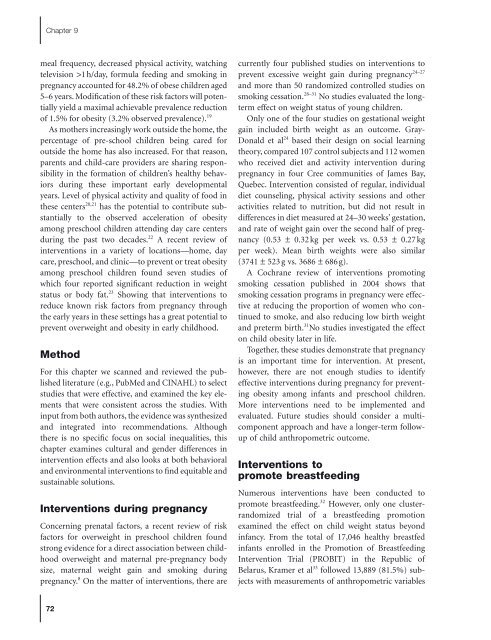Preventing Childhood Obesity - Evidence Policy and Practice.pdf
Preventing Childhood Obesity - Evidence Policy and Practice.pdf
Preventing Childhood Obesity - Evidence Policy and Practice.pdf
You also want an ePaper? Increase the reach of your titles
YUMPU automatically turns print PDFs into web optimized ePapers that Google loves.
Chapter 9<br />
meal frequency, decreased physical activity, watching<br />
television > 1 h/day, formula feeding <strong>and</strong> smoking in<br />
pregnancy accounted for 48.2% of obese children aged<br />
5 –6 years. Modification of these risk factors will potentially<br />
yield a maximal achievable prevalence reduction<br />
of 1.5% for obesity (3.2% observed prevalence). 19<br />
As mothers increasingly work outside the home, the<br />
percentage of pre - school children being cared for<br />
outside the home has also increased. For that reason,<br />
parents <strong>and</strong> child - care providers are sharing responsibility<br />
in the formation of children ’ s healthy behaviors<br />
during these important early developmental<br />
years. Level of physical activity <strong>and</strong> quality of food in<br />
these centers 20,21 has the potential to contribute substantially<br />
to the observed acceleration of obesity<br />
among preschool children attending day care centers<br />
during the past two decades. 22 A recent review of<br />
interventions in a variety of locations — home, day<br />
care, preschool, <strong>and</strong> clinic — to prevent or treat obesity<br />
among preschool children found seven studies of<br />
which four reported significant reduction in weight<br />
status or body fat. 23 Showing that interventions to<br />
reduce known risk factors from pregnancy through<br />
the early years in these settings has a great potential to<br />
prevent overweight <strong>and</strong> obesity in early childhood.<br />
Method<br />
For this chapter we scanned <strong>and</strong> reviewed the published<br />
literature (e.g., PubMed <strong>and</strong> CINAHL) to select<br />
studies that were effective, <strong>and</strong> examined the key elements<br />
that were consistent across the studies. With<br />
input from both authors, the evidence was synthesized<br />
<strong>and</strong> integrated into recommendations. Although<br />
there is no specific focus on social inequalities, this<br />
chapter examines cultural <strong>and</strong> gender differences in<br />
intervention effects <strong>and</strong> also looks at both behavioral<br />
<strong>and</strong> environmental interventions to find equitable <strong>and</strong><br />
sustainable solutions.<br />
Interventions d uring p regnancy<br />
Concerning prenatal factors, a recent review of risk<br />
factors for overweight in preschool children found<br />
strong evidence for a direct association between childhood<br />
overweight <strong>and</strong> maternal pre - pregnancy body<br />
size, maternal weight gain <strong>and</strong> smoking during<br />
pregnancy. 8 On the matter of interventions, there are<br />
currently four published studies on interventions to<br />
24 – 27<br />
prevent excessive weight gain during pregnancy<br />
<strong>and</strong> more than 50 r<strong>and</strong>omized controlled studies on<br />
smoking cessation. 28 – 31 No studies evaluated the long -<br />
term effect on weight status of young children.<br />
Only one of the four studies on gestational weight<br />
gain included birth weight as an outcome. Gray -<br />
Donald et al 24 based their design on social learning<br />
theory, compared 107 control subjects <strong>and</strong> 112 women<br />
who received diet <strong>and</strong> activity intervention during<br />
pregnancy in four Cree communities of James Bay,<br />
Quebec. Intervention consisted of regular, individual<br />
diet counseling, physical activity sessions <strong>and</strong> other<br />
activities related to nutrition, but did not result in<br />
differences in diet measured at 24 – 30 weeks ’ gestation,<br />
<strong>and</strong> rate of weight gain over the second half of pregnancy<br />
(0.53 ± 0.32 kg per week vs. 0.53 ± 0.27 kg<br />
per week). Mean birth weights were also similar<br />
(3741 ± 523 g vs. 3686 ± 686 g).<br />
A Cochrane review of interventions promoting<br />
smoking cessation published in 2004 shows that<br />
smoking cessation programs in pregnancy were effective<br />
at reducing the proportion of women who continued<br />
to smoke, <strong>and</strong> also reducing low birth weight<br />
<strong>and</strong> preterm birth. 31 No studies investigated the effect<br />
on child obesity later in life.<br />
Together, these studies demonstrate that pregnancy<br />
is an important time for intervention. At present,<br />
however, there are not enough studies to identify<br />
effective interventions during pregnancy for preventing<br />
obesity among infants <strong>and</strong> preschool children.<br />
More interventions need to be implemented <strong>and</strong><br />
evaluated. Future studies should consider a multi -<br />
component approach <strong>and</strong> have a longer - term follow -<br />
up of child anthropometric outcome.<br />
Interventions to<br />
p romote b reastfeeding<br />
Numerous interventions have been conducted to<br />
promote breastfeeding. 32 However, only one cluster -<br />
r<strong>and</strong>omized trial of a breastfeeding promotion<br />
examined the effect on child weight status beyond<br />
infancy. From the total of 17,046 healthy breastfed<br />
infants enrolled in the Promotion of Breastfeeding<br />
Intervention Trial (PROBIT ) in the Republic of<br />
Belarus, Kramer et al 33 followed 13,889 (81.5%) subjects<br />
with measurements of anthropometric variables<br />
72

















